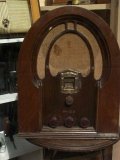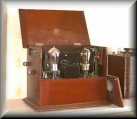Scruton question - Listening to a CD and broadcast - the same?
|
Acousmatic - music The term acousmatic 'refers to a theoretical and practical compositional approach, to particular listening and realization conditions, and to sound projection strategies. Its origin is attributed to Pythagoras (6th C. BC) who, rumour has it, taught his classes –only verbally – from behind a partition, in order to force his students to focus all their attention on his message. In 1955, during the early stages of musique concrète, the writer Jérôme Peignot used the adjective acousmatic to define a sound which is heard and whose source is hidden. By shrouding ‘behind’ the speaker (a modern Pythagorean partition) any visual elements (such as instrumental performers on stage) that could be linked to perceived sound events, acousmatic art presents sound on its own, devoid of causal identity, thereby generating a flow of images in the psyche of the listener.' http://www.sonicartsnetwork.org/ARTICLES/ARTICLE1996DHOMONT.html |
|
Beck, Alan, 2002, The Death of Radio? An Essay in Radio Philosophy for the Digital Age. Online book. Published by Sound Journal at http://www.savoyhill.co.uk/deathofradio/
The Scruton question We are back to Roger Scruton on the acousmatic experience (3.2), which he emphasised was key to music and to broadcasting. An acousmatic sound event is one which is separated entirely from its cause and is heard as a pure process (Scruton, 1997, 9). Scruton asks what is the difference between hearing a music track on a CD and the same when broadcast (Scruton, 1997, 221)? Do we get the impression of 'the same again' (109)? (This poser of a question was raised in 1.7.) Tarnay in 'The Rear Window of Essentialism' can offer some help here. My point is that focusing on the vehicle distinction is not enough and so I can come up with a reply to Scruton. Tarnay was dealing with images in two visual media - photography and cinema. He found ways to argue, contra Carroll's Theorizing the Moving Image (Carroll 1996a), that there is a distinction between a still image in a photograph and freeze frames on film:
Substitute analogue and digital for Tarnay's photography and cinema, and I suggest that a path through the Scruton conundrum is possible. References Carroll, Noël, 1996a, Theorizing the Moving Image, Cambridge: Cambridge University Press. Scruton, Roger, 1997, The Aesthetics of Music, Oxford: Clarendon Press. Tarnay, Laszlo, 1997, 'The Rear Window of Essentialism', Film-Philosophy, vol. 1 no. 6, September 1997, at http://www.film-philosophy.com/vol1-1997/n6tarnay.html |




